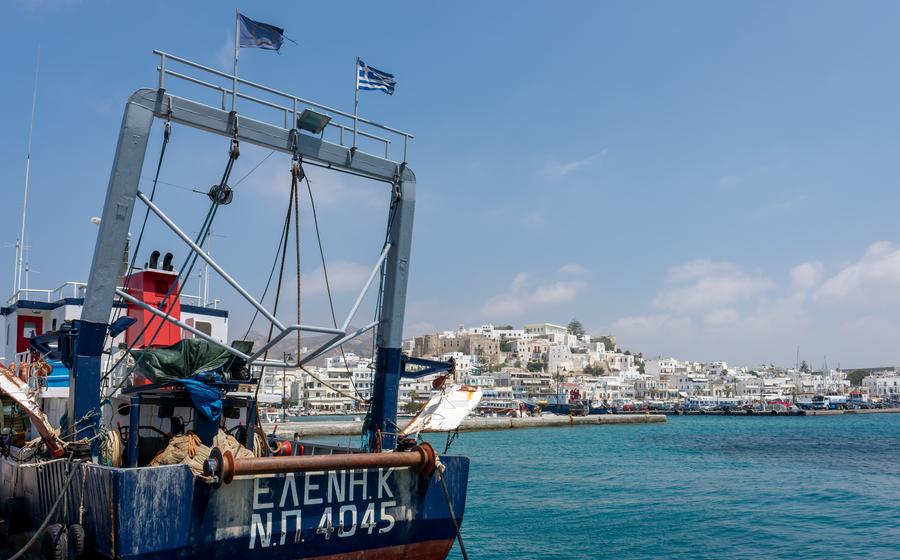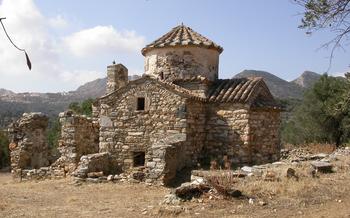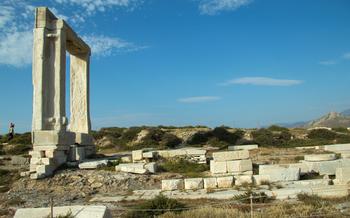
The Venetian Fortresses of Naxia
- History of the Venetian Fortresses of Naxia
- Location and Accessibility
- Exploring the Castle of Naxos
- Visiting the Smaller Venetian Fortresses
- The Archaeological Museum of Naxos
- Local Festivals and Events
- Venetian Cuisine and Local Delights
- Venetian Traces in Naxos's Heritage
- Venetian Art and Handicrafts
- Venetian-Themed Activities and Experiences
- The Venetian Legacy in Naxos's Literature and Arts
- Sustainable Tourism and Preservation Efforts
- Insider Tip: Unveiling the Hidden Gem of Agios Georgios Diasoritis
History of the Venetian Fortresses of Naxia
During the 13th century, the Venetian Republic extended its influence over the Aegean Sea, establishing a significant presence in Naxos. The strategic location of the island, at the crossroads of major trade routes, made it a valuable asset for the Venetians. To consolidate their power and protect their interests, they constructed a series of impressive fortresses, transforming Naxos into a fortified outpost. These fortresses not only served as defensive structures but also symbolized the might and grandeur of the Venetian empire.
The architectural styles of the Venetian fortresses in Naxos reflect the fusion of Venetian and Byzantine influences. The fortifications feature thick stone walls, imposing towers, and elaborate gateways, showcasing the advanced engineering skills of the Venetian builders. The strategic placement of the fortresses along the coastline and on hilltops allowed the Venetians to control access to the island and monitor maritime traffic. They played a crucial role in defending against attacks from rival powers, such as the Ottoman Empire, which sought to challenge Venetian dominance in the region.
Location and Accessibility
The Venetian Fortresses of Naxia are located on the island of Naxos, the largest island in the Cyclades archipelago. The main fortress, Naxos Castle, is situated in the island's capital city of Naxos Town, also known as Chora. The smaller fortresses are scattered throughout the island, with Kouros Fortress being the most notable one.
To reach the fortresses, visitors can take advantage of the island's public transportation system, which offers regular bus services connecting Naxos Town with the various villages and landmarks on the island. Alternatively, renting a car or hiring a taxi provides more flexibility and allows for a customized itinerary.
For those who prefer a guided experience, several tour operators offer organized excursions to the fortresses, providing historical insights and anecdotes along the way. Visitors can also opt for self-guided exploration, using maps and guidebooks to navigate the sites at their own pace.
Ample parking facilities are available in Naxos Town for those arriving by car, ensuring convenient access to the castle. The smaller fortresses may have limited or no designated parking areas, so it's advisable to plan accordingly. All the fortresses are accessible to visitors, although some may require a short walk or climb to reach the main structures.
Exploring the Castle of Naxos
The Castle of Naxos, also known as the Kastro, stands as the grandest and most significant Venetian fortress on the island. Situated atop a rocky promontory overlooking the town and harbor, it served as the administrative center and the residence of the Venetian rulers during their reign. The castle's imposing architecture is a testament to the power and influence of the Venetian Republic.
As you approach the castle, you'll be greeted by its fortified walls and sturdy towers, showcasing the defensive prowess of the Venetians. The main entrance leads you into a series of courtyards, each with its own unique charm and historical significance. Explore the Governor's Palace, once the seat of Venetian authority, with its grand halls and intricate carvings. Admire the well-preserved Venetian coats of arms that adorn the walls, remnants of a bygone era.
Climb the castle's ramparts and be rewarded with breathtaking panoramic views of Naxos Town, the Aegean Sea, and the surrounding countryside. The views from up here are simply stunning, making it an ideal spot to capture some memorable photographs. Take your time to wander through the castle's interior, soaking in the atmosphere of its ancient halls and corridors. Discover hidden nooks and crannies, each with its own story to tell. The Castle of Naxos is a treasure trove of history and culture, offering a glimpse into the glorious past of Naxos.
Visiting the Smaller Venetian Fortresses
In addition to the imposing Castle of Naxos, the island is home to several smaller Venetian fortresses, each with its own unique charm and historical significance. One notable fortress is the Kouros Fortress, situated on the southwestern coast of Naxos. Perched atop a rocky promontory, this fortress offers breathtaking views of the Aegean Sea and the surrounding landscape. Its well-preserved ramparts and towers stand as a testament to the strategic importance of this site during the Venetian era.
Another must-visit fortress is the Agios Georgios Fortress, located in the village of Agios Georgios. Built in the 16th century, this fortress played a crucial role in defending the island against pirate raids. Visitors can explore its atmospheric interior, which includes a chapel, cisterns, and remnants of living quarters.
The Apeiranthos Fortress, in the mountain village of Apeiranthos, is another notable example of Venetian fortification. Constructed in the 15th century, this fortress served as a refuge for the local population during times of conflict. Its impressive walls and towers blend seamlessly with the village's traditional architecture, creating a picturesque and historic setting.
Exploring these smaller Venetian fortresses offers a deeper insight into the island's rich history and defensive architecture. Visitors can wander through their ruins, marvel at their strategic locations, and soak up the atmosphere of these ancient strongholds.
The Archaeological Museum of Naxos
The Archaeological Museum of Naxos houses a rich collection of artifacts from the Venetian era, providing insights into the daily life and culture of the period. Among the exhibits are Venetian coins, pottery, weapons, and other objects that showcase the influence of Venetian rule on the island. Visitors can learn about the administrative, economic, and social structures of the Venetian period, as well as the artistic and cultural exchanges that took place between Naxos and the wider Venetian empire.
The museum's collection is displayed in a series of thematic sections, each focusing on a different aspect of Venetian life. One section, for example, is dedicated to the Venetian administration of the island, with exhibits on the roles and responsibilities of Venetian officials, the legal system, and the taxation system. Another section focuses on the economy of Naxos during the Venetian period, with exhibits on trade, agriculture, and industry.
The Archaeological Museum of Naxos is a valuable resource for anyone interested in learning more about the Venetian period in the island's history. The museum's collection provides a glimpse into the daily lives of the Venetian settlers and the cultural exchanges that took place between Naxos and the wider Venetian empire.
Local Festivals and Events
Naxos's Venetian heritage comes alive during the island's vibrant festivals and events. The annual Venetian Carnival is a highlight, drawing visitors from around the world. The streets of Naxos Town are transformed into a colorful spectacle, with locals and tourists alike donning elaborate costumes and masks. Historical reenactments, parades, and cultural performances fill the air with excitement and merriment.
The Feast of Saint Mark, the patron saint of Venice, is another significant event celebrated on Naxos. Religious processions, traditional music, and dancing create a festive atmosphere in the island's churches and piazzas. Throughout the year, various cultural organizations host events that showcase Venetian influences in music, art, and literature. These events provide a unique opportunity to immerse yourself in the rich cultural heritage of Naxos and experience the Venetian legacy firsthand.
Venetian Cuisine and Local Delights
The Venetian rule left an indelible mark on Naxos's culinary landscape, enriching it with unique flavors and culinary traditions. To savor the essence of Venetian cuisine, indulge in the island's signature dishes, such as the aromatic Venetian-style codfish, prepared with garlic, tomatoes, and white wine, reminiscent of the Venetian love for seafood. Another must-try is the Naxian macaroni, a traditional pasta dish with a rich tomato sauce and local cheeses.
For a truly immersive experience, venture into the charming tavernas and restaurants of Naxos Town. Seek out establishments that have preserved the Venetian spirit, often adorned with traditional décor and exuding a warm and inviting atmosphere. Here, you can savor authentic Venetian-inspired dishes, such as risotto with cuttlefish ink, stuffed squid with herbs, and Venetian-style meatballs.
Don't miss the opportunity to sample the local delicacies that have been influenced by Venetian culinary techniques. Indulge in the sweet Naxian melitinia, a filo pastry filled with honey and nuts, or the Venetian-style loukoumades, delicious fried dough balls drizzled with honey and cinnamon. These treats are a testament to the enduring legacy of Venetian cuisine on Naxos.
Venetian Traces in Naxos's Heritage
The Venetian legacy in Naxos extends far beyond its architectural treasures. The influence of the Venetian period can be felt in the island's customs, traditions, and even its language. The Venetian dialect, known as "Naxian Italian," was spoken by the island's upper classes until the early 20th century, and its echoes can still be heard in the local dialect today.
Naxos's rich history is intertwined with the Venetian rule, and many historical sites and landmarks bear witness to this era. The Venetian Castle, the Portara, and the Archaeological Museum offer tangible evidence of the Venetian presence on the island. But the Venetian influence goes beyond these iconic landmarks. It can be found in the street names, the local cuisine, and even the traditional dances and songs.
Exploring the lesser-known aspects of Naxos's Venetian heritage is a rewarding experience. Visitors can delve into the island's history by visiting the Venetian Quarter, where they can admire the charming Venetian-influenced architecture and soak up the atmosphere of a bygone era. The Venetian Quarter is home to several historical churches, such as the Church of Agios Nikolaos and the Church of Panagia Myrtidiotissa, which showcase Venetian architectural elements and religious influences.
To truly understand the Venetian legacy in Naxos, it is essential to engage with the local people. They are the keepers of the island's traditions and can share stories and insights that bring the Venetian past to life. Whether it's through conversations with elderly villagers, attending local festivals, or sampling the Venetian-inspired dishes, visitors can immerse themselves in the rich cultural heritage that Naxos has to offer.
Venetian Art and Handicrafts
The Venetian period left an indelible mark on the crafts and arts of Naxos. Venetian artisans brought their skills and techniques to the island, influencing local craftspeople and creating a unique blend of Venetian and Greek styles. Today, visitors can witness this legacy in the workshops and studios of local artisans who continue to practice traditional Venetian techniques.
In the heart of Naxos Town, you'll find workshops specializing in Venetian glassblowing, leatherworking, and jewelry making. Watch as skilled craftsmen transform molten glass into delicate vases and intricate chandeliers, or witness the creation of handcrafted leather goods and unique silver jewelry inspired by Venetian designs.
Immerse yourself in the creative process by participating in a hands-on workshop. Learn the art of Venetian mask making, creating your own unique mask to take home as a souvenir. Discover the secrets of Venetian glassblowing, shaping your own glass creation under the guidance of an experienced artisan.
When shopping for souvenirs, be sure to look for handmade items that reflect the Venetian influence. Browse the stalls at the local markets, where you can find everything from Venetian-style jewelry and pottery to hand-painted ceramics and textiles.
By supporting local artisans and purchasing their handmade creations, you not only take home a piece of Naxos's Venetian heritage but also contribute to the preservation of traditional crafts and the livelihood of local communities.
Venetian-Themed Activities and Experiences
Embark on a journey through time and immerse yourself in the captivating world of Venetian Naxos. Participate in a gondola ride along the picturesque waterfront, allowing you to experience the island from a unique perspective. Unleash your creativity at a Venetian mask-making workshop, where you can craft your own personalized souvenir while learning about the rich tradition of mask-making. Delve deeper into the Venetian legacy by attending historical reenactments that bring the past to life, showcasing the vibrant culture and customs of the era. Engage in interactive exhibits and educational programs designed for visitors of all ages, providing an immersive and informative experience. Create a truly memorable and enriching Venetian experience by embracing these special activities and programs.
The Venetian Legacy in Naxos's Literature and Arts
The Venetian period has left an indelible mark on Naxos's cultural heritage, inspiring generations of local artists and writers. Literature and Arts have served as powerful mediums for expressing the island's Venetian identity and capturing the essence of this unique era.
Numerous books and poems have been written about the Venetian period in Naxos. These works often explore themes of love, loss, and the clash of cultures, providing a glimpse into the lives of the island's inhabitants during this time. Local authors such as Nikos Kazantzakis and Yannis Ritsos have drawn inspiration from the Venetian era, weaving its history and traditions into their literary masterpieces.
Painting and other forms of visual art have also played a significant role in preserving and interpreting the Venetian legacy in Naxos. Many local artists have found inspiration in the island's Venetian architecture, landscapes, and people, creating works that evoke the spirit of this bygone era. Murals, sculptures, and mosaics depicting Venetian scenes can be found throughout Naxos Town and the surrounding villages, adding to the island's artistic charm.
Discovering the literary and artistic treasures of Naxos is an essential part of understanding the island's Venetian heritage. Visitors can explore local bookstores, galleries, and museums to learn more about the works inspired by this period. By delving into the creative expressions of Naxos's artists and writers, travelers can gain a deeper appreciation for the island's rich cultural tapestry.
Sustainable Tourism and Preservation Efforts
Preserving Naxos's Venetian heritage for future generations is crucial to ensuring its enduring legacy. Several initiatives are underway to protect and restore Venetian sites and landmarks, including the restoration of historical buildings, the establishment of heritage trails, and the implementation of conservation measures. Sustainable tourism practices play a vital role in this endeavor, as they help support local communities and protect the environment.
As a responsible traveler, you can contribute to the preservation of Naxos's Venetian legacy by choosing tour operators that prioritize sustainability, respecting historical sites and monuments, and minimizing your ecological footprint. By supporting local businesses, you directly contribute to the preservation of the island's cultural heritage. Additionally, consider exploring the Venetian heritage beyond the main tourist attractions to discover hidden gems and lesser-known sites that offer a unique perspective on the island's past.
Remember, the Venetian heritage of Naxos is a precious and irreplaceable asset that should be cherished and preserved for generations to come. By embracing sustainable tourism practices and supporting local initiatives, you can help ensure that the legacy of Venice continues to thrive on this beautiful island.
Insider Tip: Unveiling the Hidden Gem of Agios Georgios Diasoritis
Beyond the well-trodden paths of Naxos's Venetian landmarks, lies a hidden gem that offers a unique glimpse into the island's rich past. Perched atop a hill overlooking the azure waters of the Aegean Sea, the Venetian fortress of Agios Georgios Diasoritis stands as a testament to the island's strategic significance during the Venetian era.
This lesser-known fortress, often overlooked by tourists, offers a tranquil retreat from the bustling crowds. As you approach the fortress, you'll be greeted by breathtaking panoramic views that stretch across the island's rugged terrain and sparkling coastline. Take a moment to soak in the serenity of the surroundings before embarking on an exploration of the fortress's well-preserved ruins.
Unlike the more popular Venetian fortresses, Agios Georgios Diasoritis has retained much of its original charm and authenticity. Wander through its crumbling walls and discover hidden chambers, secret passageways, and remnants of Venetian architecture. Let your imagination transport you back in time as you envision the fortress's former glory, when it served as a vital defensive outpost for the Venetian rulers of Naxos.
To reach this hidden gem, you'll need to venture off the beaten track. A scenic hike or bike ride through the picturesque countryside will lead you to the fortress's secluded location. Alternatively, you can arrange a private tour with a local guide who can provide insights into the fortress's history and significance.
Remember, the fortress is exposed to the elements, so be sure to pack water, sunscreen, and a hat. Also, wear comfortable shoes as the terrain can be uneven. And while you're there, take a moment to appreciate the tranquility of this hidden gem, far from the madding crowds.
Exploring Agios Georgios Diasoritis is not just a journey through history, but an opportunity to connect with the authentic spirit of Venetian Naxos. So, if you're seeking an off-the-beaten-path adventure, make sure to include this hidden gem in your itinerary.









